The Hen Medic
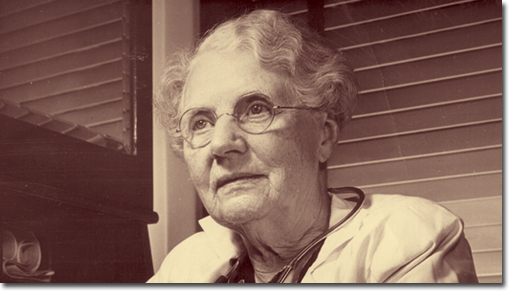
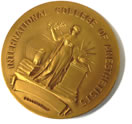 When Bertha Van Hoosen was a medical student at U-M in the late 1800s, women's health
was a public health crisis.
When Bertha Van Hoosen was a medical student at U-M in the late 1800s, women's health
was a public health crisis.
The pioneering Van Hoosen helped change that through life-saving science.
I had never heard of a woman physician," wrote Bertha Van Hoosen in her memoir about the moment she stumbled across not one but two women studying medicine at the University of Michigan in 1884.
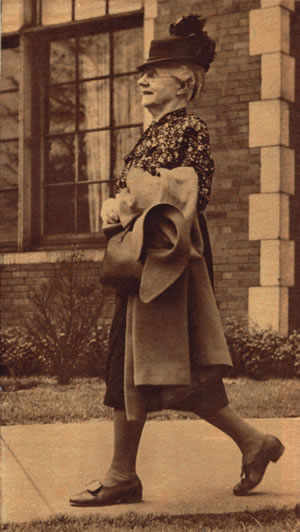
The medallion above and the
Students Mary McLean and Harriet Barringer, who were living in a boarding house across the street from Van Hoosen, were a wonder not just to Van Hoosen—but to society writ large. Women had been admitted into the university little more than a decade prior, in 1870, to the distaste of many. U-M's first president, Henry Philip Tappan, wrote to a friend saying giving women an education would "disturb God's order" and "produce monstrosities."
The idea that a woman could not only attend college but also advance the prestigious field of medicine was downright revolutionary. Into this prejudice stepped Bertha Van Hoosen, who was born and raised on a small farm in Stony Creek, Michigan, and would later say that her study of anatomy—her favorite subject—was "begun in the [farm's] back yard at hog-killing time."
Van Hoosen's U-M degree was the first step in a long career pioneering the advancement of health for mothers and babies. She would go from not even understanding that a woman physician could exist to blazing trails for future generations.
It was a critical time for such a role. The average American woman in the 18th and 19th centuries had seven live births in her lifetime. Data suggests that 10 percent of mothers and 14 percent of babies died during the birth process in the late 19th century. Even if the mother survived, there was a high likelihood that lacerations, tears, and injuries during birth would lead to pain, incontinence, and difficulty with future pregnancies. Creating life was a public health crisis that produced injury and death.
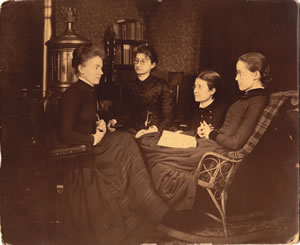
At U-M, Van Hoosen and her female
At the turn of the century, physicians were slowly replacing midwives in attending women in childbirth. However, they rarely traveled outside their area of practice and were largely available only for those who could afford them. This gave wealthy urban women more options, but poor, rural women or immigrants or people of color had little help. In the impoverished area of Hells Kitchen, New York, at the turn of the century, for example, newly appointed health inspector Dr. Josephine Baker discovered that 1,500 newborn babies died in the district every week.
Even when medical expertise was available, it was questionable. Sanitation and hygiene concerns, myths about women's reproduction, and the use of tonics and addictive painkillers like opium often made women's reproductive health more art than science. Added to this were gender norms that kept women from seeing a male physician for modesty reasons. Van Hoosen wrote in her memoir that she believed women were suffering and dying because "they couldn't submit to an examination by a male physician."
During her decades of work, Van Hoosen would pioneer advancements that made childbirth healthier for women everywhere and improved women's heath overall. From implementing sanitation standards to educating physicians and women in the community directly, she was a tireless teacher and healer—beginning in 1888 when she graduated from U-M's medical school to her death in 1952.
Through a Surgical Door
At U-M, Van Hoosen and her female medical colleagues were called "hen medics" or "petticoat surgeons," the latter of which became the title of her memoir. She writes about being demure in school—"I exercised care never to raise my eyes from the ground going to and from class, and when in class I directed my attention at the professor"—and in her first few positions after graduation, she describes being tentative, overwhelmed by "the responsibility for the life of a patient."
When Bertha Van Hoosen was a medical student at U-M in the late 1800s, women's health was a public health crisis. The pioneering Van Hoosen helped change that through life-saving science.
After working and training for four years at the Women's Hospital at the Michigan State Asylum for the Insane and the New England Hospital for Women and Children in Boston, Van Hoosen packed up and moved to Chicago to open her own practice. Patients were still wary of a female physician, and money was tight. So when she was asked to serve as the emergency physician for three days during the Chicago World's Fair in 1893, she readily agreed.
There, a German immigrant came to see her with a sick child, and Van Hoosen treated the baby. After she sent them on their way and promised to call on them later, a male physician berated her, arguing that immigrants never listen and that the best course was always to give them a placebo—"sugar or bread pills"—because they were too ignorant to do what a physician told them. Concerned and upset, Van Hoosen tracked down the family that evening, only to find the baby much improved. The German mother told all of her neighbors about Van Hoosen's skills, and the problem of clients in her private practice was solved. "From then on, like a spring, [patients] almost burst upon me," Van Hoosen wrote.
Van Hoosen's career was a mix of private practice and hospital appointments in obstetrics and gynecology, while always keeping surgery as part of her work. "Because I am a woman, to specialize in obstetrics would brand me as a midwife," she wrote. She decided to enter obstetrics "through a surgical door."
However, early on Van Hoosen witnessed many of her patients contracting fevers after surgery, which prompted her to teach sterilization techniques. "I discovered that nurses did not understand how to sterilize sponges, or properly prepare the operating room."
For years, Van Hoosen would sterilize much of the operating equipment herself at home, then pack it into her buggy and transport it to the surgery. Before any operation, she would arrive and "[wipe] all the furniture with lysol solution," doggedly fighting infection and imploring others to do the same.
Van Hoosen was also determined to relieve women of the pain and "lift the centuries-old fear" of childbirth. Beginning in the mid-1800s, ether was a popular anesthetic, but it could also stop uterine contractions and drug—or even kill—newborns. Chloroform was also used, but this too stopped contractions, and Van Hoosen wrote that it was "bad for the liver" and could harm infants.
By 1915 Van Hoosen had written a book on scopolamine morphine—a drug first pioneered by Dr. Emil Ries, a Chicago surgeon—which kept the mother conscious during childbirth but didn't lessen contractions. It alleviated pain and also left the mother with "no memory" of the childbirth. This was coined as "twilight sleep," and Van Hoosen was its evangelist for decades, arguing against convention that it was safe enough to use in home births as well as hospitals.
Also in 1915, she helped establish the American Medical Women's Association—this in spite of petitions that were circulated by male physicians condemning the organization. She served as the organization's first president.
In 1918 Van Hoosen was offered the position as acting head and professor of obstetrics at Loyola University Medical School—and became the first woman to hold such a position at a co-ed medical school. When she arrived, she was horrified to find that a large number of seniors, on the cusp of graduation, "had never seen a confinement case, much less assisted in a birth."
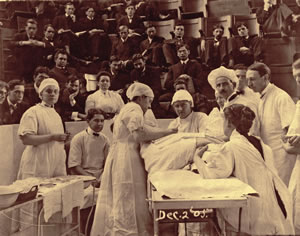
The idea that a woman could not
Van Hoosen worked steadfastly to educate men and women in obstetrics, gynecology, and women's health everywhere she went. She taught the pioneering technique of caesarian-section surgery, which saved mothers' lives in difficult births, and she was determined to help train up the next generation of women surgeons, whom she often referred to as "her surgical daughters." In rural areas especially, Van Hoosen made the rounds with women physicians in their communities, helping with births, surgery, and much more. In Chicago public schools, she lectured about sex education to hundreds of high school senior girls, arguing that "ignorance on no other subject could be more productive of bad results."
"An Opportunity to Balk You"
Not that it always went smoothly. Early in Van Hoosen's career, in 1901, the position of professor of obstetrics and gynecology opened at U-M. Van Hoosen traveled from Chicago to Ann Arbor to visit Dr. Victor Vaughn, whom she knew from her days as a medical student. He told her directly that she couldn't have the position because she was a woman, to which Van Hoosen replied, "If my own university will not administer justice to my sex, I will find some other school that will."
By 1902 she was a clinical gynecology professor at the Illinois University Medical School, but the male students revolted when she tried to give them an exam—overturning furniture and nearly rioting. The faculty at one point refused to let her move a patient from the surgical "theater" back into the hospital. The dean, Dr. William Quine, told her, "They do not want a woman surgeon on the faculty, and have watched for an opportunity to balk you."
In spite of these obstacles, Van Hoosen was determined. "I took no vacations, never read the newspapers, I limited my reading to medicine, and seldom allowed my thoughts to wander from my professional duties," she wrote.
Van Hoosen never married and was the single breadwinner for her family back in Michigan. Her father had passed away, leaving her mother and her widowed sister, Alice, along with Alice's daughter, Sarah, to run the farm by themselves. Sarah would go on to attend the Agricultural College at the University of WisconsinÐMadison and become the first female "master farmer" in Michigan and one of the first in the United States. Today, the Van Hoosen farm is the site of Michigan's Rochester Hills Museum.
Van Hoosen wrote her memoir, Petticoat Surgeon, at the age of 84. When she died in 1952 at the age of 89, she was the oldest practicing woman doctor in the United States, and by that year, the infant mortality rate had dropped to around 3 percent. From 1900 to 1997, the maternal mortality rate declined almost 99 percent—certainly due in no small part to her contributions. In 2016, the Institute of Health Metrics and Evaluations reported that the maternal mortality number was on the rise again and likely had been since 2000, especially among poor black women.
Sources for this article:
- Centers for Disease Control and Prevention, Morbidity and Mortality Weekly Report (October 1, 1999)
- Institute for Health Metrics and Evaluation, Sustainable Development Goals (2015)
- Judith Walzer Leavitt, Brought to Bed: Childbearing in America 1750Ð1950 (Oxford University Press, 1986)
- Bertha Van Hoosen, Petticoat Surgeon (Chicago: People's Book Club, 1947)


